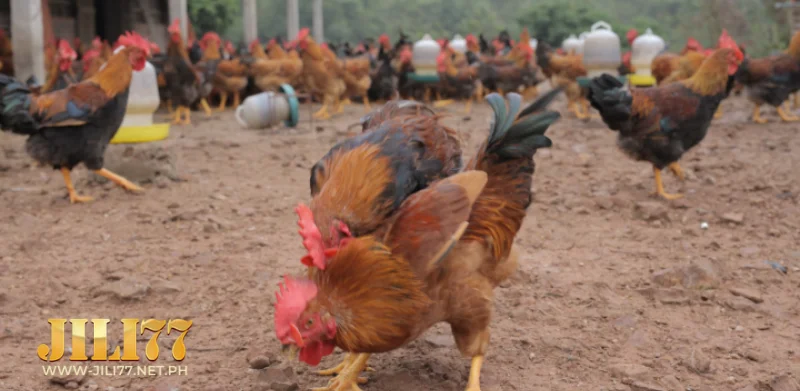To distinguish between fighting chickens and meat chickens, it is necessary to clearly understand the characteristics, body structure, feeding regime, as well as the purpose of use of each type. These two types of chickens have different biological characteristics and shapes due to different feeding methods, breeding goals, and specialized development processes.
From observing their appearance to the way they move, their personality, and body structure, each factor helps to clearly identify the difference between fighting chickens and meat chickens. Join Jun88 to analyze the specific characteristics to help quickly distinguish, from shape, physique, feeding regime, to economic value.
Distinguishing fighting chickens and meat chickens based on body shape and size
If you pay close attention to fighting chickens and meat chickens, it is not difficult to see that fighting chickens often have a firm body, with strongly developed muscle bundles. They have large bones, bulging muscles in parts such as wings, thighs & back, helping them endure well when participating in intense matches. Their mass is also often larger, but more importantly is muscle density, because strong muscles help legs to be flexible and durable.
In addition, the fighting type has long, strong legs, big, sharp toes, along with a hard & pointed beak – which are necessary factors to defend and attack opponents.
On the contrary, when looking at fighting chickens and meat chickens, we see that the meat type has a softer body, small bones, and does not have outstanding muscle bundles like fighting chickens. The skin and feathers of the meat type are often smooth, not rough or dense. They grow quickly thanks to a diet rich in protein and energy. Because they do not need to move much, they often have a larger, rounder body. The legs of the meat type are shorter, less flexible, and the toes are not as sharp and thick as the fighting type.

Fighting chickens and meat chickens are different in personality and activity
Fighting chickens and meat chickens have quite contrasting personalities. Fighting chickens are often well-trained, aggressive, sharp, and very flexible. They are trained to fight, so they have the ability to improvise and react quickly to attacks. In addition, they are highly disciplined due to being trained systematically from a young age. They are often very active, like to move, and do not stay in one place. The resilient and brave personality is a highlight of fighting chickens that we can easily see from the way they observe and react to their surroundings.
Meat breeds are often gentle and inactive. Because they are raised mainly in narrow spaces or cages with limited conditions, meat breeds do not need to train their fighting ability or flexible reflexes. They are also less sensitive to the surrounding environment, mostly focusing on eating to gain weight. Therefore, we can easily recognize the slow, unresponsive attitude, which is the result of being raised in safe conditions, without having to worry about external factors.

Diet & care are not the same
Fighting chickens and meat chickens have completely different diets and care methods, in order to optimize the use of each type. Fighting chickens need a special diet to develop muscles and endurance, often including protein-rich foods such as meat, fish, egg yolks and fresh vegetables. This rich source of nutrition helps fighting chickens maintain good health, strengthen muscles, and prepare them for matches. In addition, they are trained daily through exercises such as flying, running, and leg training to increase fighting ability.
In contrast, meat chickens are mainly raised with a high-energy diet to gain weight quickly. They are often fed industrial foods with high nutritional content but do not require too much protein, but focus on starches, helping to accumulate fat and muscle. Raising meat breeds focuses on weight gain rather than muscle strength, so they do not need to participate in complex exercise exercises. The raising regime usually lasts about 6-8 weeks to reach the ideal weight before being sold to the market.

The purpose of raising fighting chickens and meat chickens
All the different characteristics of fighting chickens and meat chickens start from the purpose of raising. Fighting chickens and meat chickens have been divided into many different types from the starting point of raising purposes.
Fighting chickens
Usually, the raised breeds have higher economic value, especially those fighting chickens that have achieved outstanding results in cockfighting matches. A good fighting chicken can cost quite a lot, even more depending on its reputation and fighting ability. They are raised and trained carefully, and are real warriors in the fighting village. They are even considered a valuable asset to many enthusiasts, willing to invest heavily to own and raise them.
See more: Thomo cokfighting JILI77
Broiler chickens
Although it has a lower value, it plays an important role in the industrial livestock industry. Widely consumed, and is also the main source of food in the daily meals of many families, this type of meat meets the great demand of the market thanks to its ability to grow quickly, low cost of raising, and stable selling price. Because of this popularity, this type of meat is a key product of industrial farms.
Conclusion
The difference between fighting chickens and meat chickens is not only a matter of form but also lies in the way of raising, the purpose of use, and economic value. From appearance, personality, nutrition, to commercial value, each factor contributes to creating distinct differences between the two types.
The breed raised for fighting is the embodiment of strength, courage, and meticulous investment from the breeder, while the breed raised for meat is a symbol of abundance and a stable food supply for the market. JILI77 hopes that you understand how to distinguish between fighting chickens and meat chickens, not only to help breeders but also to give you a deeper insight into the value and role of each type in life and the economy.
David Moi’s journey to turn JILI77 into a leading online casino in the Philippines. With a diverse online game system and the support of players. Find out through the article below.

